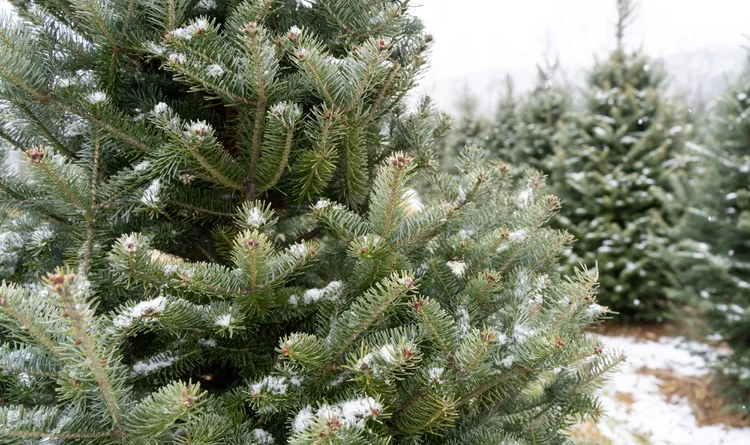How to Plant and Grow a Fraser Fir Tree for Year-Round Beauty
Fraser fir is a beloved type of Christmas tree that also offers privacy, beauty, and wildlife value to gardens.
The Fraser fir tree (Abies fraseri) is a comparatively rare sight in the wild. Fortunately, that’s not the case closer to civilization. In fact, it’s a common sight during the holidays especially. Fraser fir has become one of the most popular Christmas trees due to its attractive color and shape, fragrance, excellent needle retention, and slightly upturned branches capable of displaying loads of ornaments.
In the home landscape, this medium-size conifer makes an excellent specimen tree with year-round appeal. Homeowners love the blue-green foliage with silvery white undersides. The cones are unique, too, taking on a two-tone appearance in summer before maturing seeds into a food source for squirrels and other small mammals. Meanwhile, Fraser fir’s strong, stiff branches and dense foliage make it a favorite nesting spot for birds.
To add this pretty, wildlife-friendly tree to your yard, use this guide to learn how to grow and care for a Fraser fir.
Where to Plant a Fraser Fir Tree
Like any tree, a Fraser fir should be planted where it has ample room to reach its mature size without overtaking other plants or threatening nearby structures. Plant it as a living screen wherever you want some year-round privacy. Or surround it with smaller evergreens in a mixed conifer garden. Fraser fir also makes a good specimen plant in the front yard, where it will greet passers-by throughout the year. In large landscapes, plant several Fraser firs in a small grove to recreate a wildlife habitat.
How and When to Plant Fraser Fir Trees
Early spring or fall is the best time to plant Fraser fir. It is often sold as a container plant but can be ordered bare root through mail-order nurseries. Dig a hole that is as deep as the height of the root ball but twice as wide. Remove the tree from its container. If the roots are tightly wound, cut them with a saw at four equidistant places to encourage them to migrate into surrounding soil rather than continue to circle the root ball.
Place the tree in the hole so the tapered base of the trunk is level with the surrounding grade. Backfill the planting hole with the excavated soil, firmly tamping it to eliminate larger air pockets. Spread a 2-inch layer of mulch over the root zone, keeping the mulch several inches away from the tree’s trunk. Water the tree slowly and deeply so the water seeps into the soil rather than running off.
Related: 13 Fast-Growing Trees for a Privacy Screen in Your Yard
Fraser Fir Tree Care Tips
Fraser fir is a relatively low-maintenance tree as long as the conditions are suitable.
Light
Plant Fraser fir where it will receive six to eight hours of sunlight each day. It can take partial shade and in hot climates may actually benefit from a respite from the sun’s rays in the afternoon.
Soil and Water
Fraser fir prefers a rich, moist, slightly acidic soil that is well drained. It does best in loamy soils; heavy clays drain too slowly and will cause Fraser fir to suffer and decline. It is also intolerant of salt from winter de-icing, so keep it away from driveways and sidewalks. Fraser fir requires regular watering the first two years after planting and supplemental watering during drought.
Temperature and Humidity
Being native to the cool, moist slopes and high altitudes of the southern Appalachian Mountains, Fraser fir is not accustomed to extremely hot weather and therefore not recommended for hot, humid climates south of Zone 7.
Fertilizer
Fraser fir doesn’t require fertilizer. Because it is relatively shallow-rooted, though, it may benefit from a 2-inch layer of organic mulch, which will conserve moisture, keep roots cool, and eventually break down to add nutrients.
Pruning
With its pyramidal shape and thick branching, Fraser fir has a naturally attractive shape that should not need pruning unless a branch is damaged or dead.
Pests and Problems
The two major threats to Fraser fir are a tiny insect and a fungus:
Balsam woolly adelgid is an introduced pest that has become a major threat to Fraser fir trees in the wild. An initial infestation causes swelling and dieback of buds and twigs and a heavy infestation can kill a tree. The tiny wingless insects are hard to see with the naked eye but their presence is easy to detect due to the white woolly mass that covers the adult insects and their eggs.
Phytophthora root rot is the other prominent threat. It is more likely to occur in heavy, poorly drained soils, causing yellow-green needles, wilting, slow growth, dead branches, and eventually death of the tree.
Other pests, such as bark beetles, spruce budworms, aphids, bagworms, and scale can also cause problems. In hot conditions, spider mites may appear.
How to Propagate Fraser Fir Trees
Collect sticky cones in late summer or early fall and set out to dry. They will eventually shatter into bracts, seeds, and stems. Save the seed, refrigerate in a sealed plastic bag for three or four months, then sow in pots filled with seed-starting soil mix.
Fraser firs grow slowly, only about 1 inch the first year, 1 foot in five years, so a quicker option is to buy bare-root seedlings from a mail-order nursery or start new plants from cuttings. This involves snipping 5-7-inch sections of new growth from trees, removing needles from the bottom two-thirds, dipping the cut end in rooting hormone, and placing in moist potting mix in a cool area with indirect light. Rooting can take half a year or longer.
Types of Fraser Fir Trees
Look for the following types of Fraser firs as attractive variations on the species.
Canaan Fir
Closely related to Fraser fir and Balsam fir (it’s possibly a naturally occurring hybrid of the two) it originated in the Canaan Valley of West Virginia and has become a popular Christmas tree due to its attractive appearance. Outdoors, it is said to be more tolerant of wet conditions than Fraser fir.
‘Fastigiata Compacta’
This compact, columnar, semi-dwarf cultivar grows just 6 feet tall and 2 feet wide in a decade.
‘Klein’s Nest’
A compact, rounded, densely branched cultivar, it has shorter needles than the species and grows about 30 feet tall.

‘Prostrata’
This slow-growing cultivar matures into a spreading, mounded shape, 4-5 feet tall, 12-14 feet wide.
Fraser Fir Companion Plants
In the wild, Fraser fir often grows with other types of fir trees. In the home garden, you can pair it with companions that like the same acidic, moist, well-drained soils.

Magnolias
Magnolias have showy blooms, sometimes appearing before the leaves in spring. These flowering woody plants come in a range of species and cultivars from shrubs and small trees to large trees.

Rhododendrons
Rhododendrons like the same moist, well-drained, acidic soils as Fraser firs and offer a variety of sizes and flower colors. Some have pretty fall color, others boast the ability to bloom a second time the same growing season.

Blueberries
Blueberries are another companion plant with similar needs as Fraser fir. They offer tasty berries for people or wildlife. The plants themselves also have attractive fall color.
Frequently asked Questions
Where does Fraser Fir grow in the wild?
It is native to the southern Appalachian Mountains of Virginia, North Carolina, and Tennessee but commonly planted as an ornamental in lower altitudes.
How can I tell Fraser fir and Balsam fir apart?
Although the two similar-looking species are both Christmas tree favorites, there are a few telltale differences. Fraser fir grows slower than Balsam fir and has stronger branches. The foliage has more contrast than that of Balsam. Moreover, the pointy needles feel sharp when grasped in the hand. While Balsam fir is more fragrant, Fraser fir holds its needles longer as a cut tree.
How long does Fraser fir live?
If given the right growing conditions, Fraser fir can live 150 years.
Why is it called Fraser fir?
The tree was named after John Fraser, an 18th century Scottish botanist who discovered the species and introduced it to Britain.
Original post by Luke Miller from feeds.distribution.dotdashmeredith.com




